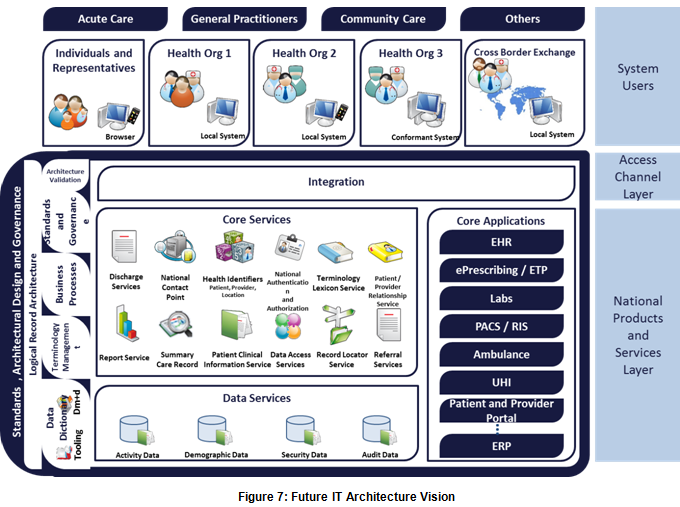The IT Architecture Vision
The high level future IT architecture vision is illustrated in Figure 7 below, and each of the elements described briefly below.

Care Settings and System Users
Different healthcare organisations are depicted under the care settings of Acute Care, General Practitioners, Community and Others. Organisations will include users such as patients, clinicians, social, mental health and community workers. Organisations will have local technology systems, which can be integrated with the HSE core systems. To facilitate this, the architecture will define, certify and enforce standards for integration, requiring that systems are conformant with the standards before integration can proceed.
The integration tier provides a single logical gateway into core HSE systems, and standards based channels for synchronous and asynchronous messaging between local users, local systems and the HSE core. Key functions will include security, messaging, and auditing. In practice, the integration tier is likely to be implemented through a number of specialised systems. It will initially include the integration functionality in PCRS and HealthLink. Over time, this will be evolved based on integration and security requirements. Future components may comprise commercial off the shelf products (COTS) or Open Source technologies. In either case, a cost assessment must verify and include the cost of support requirements in the decision making and business case.
On a phased basis, integration with core systems (e.g. use of the IHI) will become mandatory. The approach by which individual organisations implement this integration will be determined by them, in conjunction with a design authority. The role of the design authority will be to provide overall governance to ensure coherent design that shares appropriate data at each stage of the patient pathway.
Core Services
Core Services comprises key national HSE systems that are used by other systems and applications, such as IHI, or Referral Services. These are the kernel of the architecture and enable the functional connections between applications. The core services shown in the HSE future architecture have been identified based on the requirements for integration, and consistent views and behaviour across systems and care settings. For example, the requirement for clinicians to have a synopsis of a patient’s history is met by the Summary Care Record core service and necessary integration with this. The services that are defined are logical services. Services perform functions within an overall Service Oriented Architecture (SOA). Services may be physically implemented using existing systems or through new systems, either COTS or Open Source. Services, and the HSE SOA, will be governed by the HSE Design Authority.
Data Services
A number of logical data services are depicted. The architecture states that defined HSE datasets should be normalised, integrated and held centrally where necessary to support business capabilities. The detailed contents of these will be driven by the information architecture and the detailed design of core applications and core services, the definition of which will continue to evolve and mature as the new Knowledge & Information capabilities are implemented. Clinical experts will be the lead stakeholder for the content of datasets, with the Design Authority supporting the technology and process. These data services underpin the availability of management information throughout core applications.
Core Applications
As noted above in “Care Settings and System Users”, applications may be central or local. Applications include clinical and administrative applications for all care settings. Regardless of whether applications are central or local, they will integrate using the same standards with the Core Services.
A Core Application is a central national application, typically deployed as a single instance. As local applications require replacement or major upgrades, consideration will be given to migrating instead to a national core application, where available. Use of national core applications should improve the level of integration while reducing the cost of integration.
Standards and Architectural Design and Governance (Design Authority)
Effective communication requires that information issuers and recipients share a common “reference framework” that allows for interaction. Standards provide this common framework, promoting uniformity in the definition and identification of health system components, whether they are objects, diagnosis, people, or interventions.
The Enterprise Architecture function, leading the Design Authority, will be responsible for the definition of these standards and the design of technology to meet business capability and process requirements. The function will work closely with the health service and clinicians in particular to shape the design of functions and capabilities, and govern and enforce the standards.
